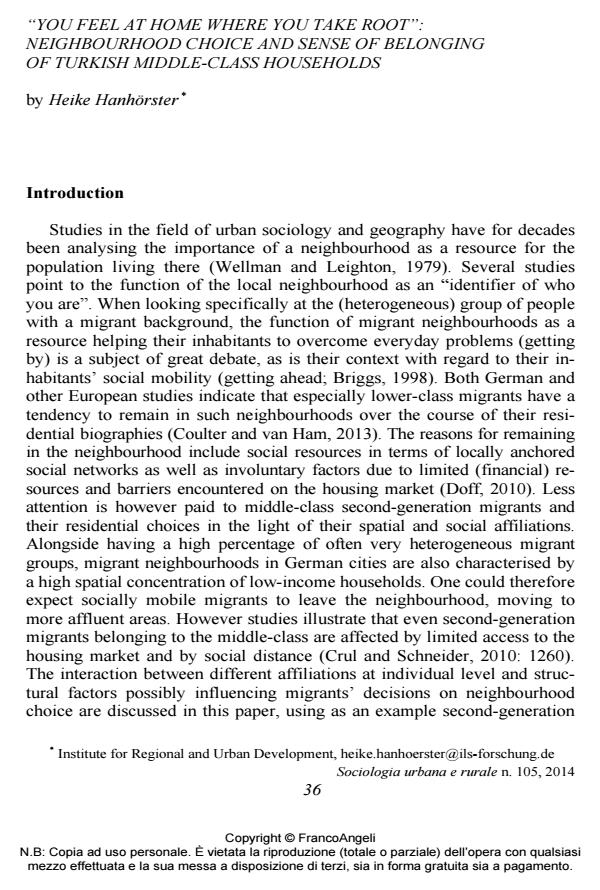"You Feel At Home Where You Take Root": Neighbourhood Choice And Sense Of Belonging Of Turkish Middle-Class Households
Titolo Rivista SOCIOLOGIA URBANA E RURALE
Autori/Curatori Heike Hanhörster
Anno di pubblicazione 2014 Fascicolo 2014/105 Lingua Inglese
Numero pagine 14 P. 36-49 Dimensione file 219 KB
DOI 10.3280/SUR2014-105003
Il DOI è il codice a barre della proprietà intellettuale: per saperne di più
clicca qui
Qui sotto puoi vedere in anteprima la prima pagina di questo articolo.
Se questo articolo ti interessa, lo puoi acquistare (e scaricare in formato pdf) seguendo le facili indicazioni per acquistare il download credit. Acquista Download Credits per scaricare questo Articolo in formato PDF

FrancoAngeli è membro della Publishers International Linking Association, Inc (PILA)associazione indipendente e non profit per facilitare (attraverso i servizi tecnologici implementati da CrossRef.org) l’accesso degli studiosi ai contenuti digitali nelle pubblicazioni professionali e scientifiche
Numerosi studi evidenziano l’importanza del vicinato locale come "fattore della propria identità". Nel presente contributo vengono discussi l’interazione tra diverse affiliazioni e il conseguente effetto sulle decisioni degli immigrati per quanto concerne la scelta del vicinato. Lo studio si concentra sulle scelte residenziali dei nuclei familiari del ceto medio turco in Germania, analizzando le loro scelte di compromesso tra appartenenza locale e posizionamento sociale in fase di acquisto della proprietà.
Keywords:Scelta del vicinato, appartenenza, vicinati a basso reddito, rilocazione residenziale, immigrati, affiliazione
- Alba R. (2005): Bright vs. blurred boundaries: Second generation assimilation and exclusion in France, Germany, and the United States. Ethnic and Racial Studies, 28: 1: 20-49. DOI: 10.1080/014198704200028000
- Andreotti A., Le Galès P., Moreno Fuentes F.J. (2013). Controlling the Urban Fabric: The Complex Game of Distance and Proximity in European Upper-Middle-Class Residential Strategies. International Journal of Urban and Regional Research, 2: 576-597. DOI: 10.1111/j.1468-2427.2012.01177.
- Antidiskriminierungsstelle des Bundes (Federal Anti-Discrimination Agency) (ed.) (2009).
- Diskriminierung im Alltag. Abschlussbericht, Berlin.
- Bergström L., van Ham M., Manley D. (2010). Neighbourhood Choice and Neighbourhood Reproduction. In Institute for the Study of Labor (Eds.): Discussion Paper 5238, October
- 2010. Bourdieu P. (1991). Physischer, sozialer und angeeigneter physischer Raum. In Wentz, M. (Ed.). Stadt-Räume. Frankfurt am Main: New York.
- Briggs X., de S. (1998). Brown Kids in White Suburbs: Housing Mobility and the Multiple Faces of Social Capital. Housing Policy Debate, 1: 177-221. DOI: 10.1080/10511482.1998.952129
- Butler T., Robson G. (2001). Social Capital, Gentrification and Neighbourhood Change in London: A Comparison of Three South London Neighbourhoods. Urban Studies 12: 2145-2162. DOI: 10.1080/0042098012008709
- Coulter R., van Ham M. (2013). Following people through time: An analysis of individual residential mobility biographies. Housing Studies, 7: 1037-1055. DOI: 10.1080/02673037.2013.78390
- Crul M., Schneider J. (2010). Comparative integration context theory: participation and belonging
- in new diverse European cities. Ethnic and Racial Studies, 7: 1249-1268. DOI: 10.1080/0141987100362406
- Doff W. (2010). Puzzling neighbourhood effects: Spatial selection, ethnic concentration and neighbourhood impacts. Delft: IOS Press.
- Granovetter M.S. (1973). The strength of weak ties. American Journal of Sociology, 78: 1360-1380. DOI: 10.1086/22546
- Hanhörster H. (2000). Whose neighbourhood is it? Ethnic diversity in urban spaces in Germany. GeoJournal, 4: 329-338. DOI: 10.1023/A:101227301451
- Holm A. (2014). Die Wiederkehr der Wohnungsfrage. APuZ, 20-21.
- Horr A. (2008). Ethnische und soziale Unterschiede in der Wohnungssuche. In Hillmann, F.;
- Windzio, M. (ed.) Migration und städtischer Raum. Chancen und Risiken der Segregation und Integration. Opladen.
- Jenkins R. (2008). Social Identity. London, New York: Sage.
- Lacy K.R. (2004). Black spaces, black places: Strategic assimilation and identity construction in middle-class suburbia. Ethnic and Racial Studies, 6: 908-930. DOI: 10.1080/014198704200026852
- Münch S. (2009): “It’s all in the mix” - Constructing ethnic segregation as a social problem in Germany. Journal of Housing and the Built environment, 4: 441-455. DOI: 10.1007/s10901-009-9160-
- Noreisch K. (2007). School catchment area evasion: the case of Berlin, Germany. Journal of Education Policy, 1: 69-90. DOI: 10.1080/0268093060106575
- Savage M., Bagnall G., Longhurst B. (2005). Globalization and belonging. London: Sage. Sürig I., Wilmes M. (2011). Die Integration der zweiten Generation in Deutschland.
- Ergebnisse der TIES-Studie zur türkischen und jugoslawischen Einwanderung. IMISBeiträge, 93. DOI: 10.1007/s11578-005-0035-
- Sutterlüty F., Walter I. (2005). Übernahmegerüchte. Klassifikationskämpfe zwischen türkischen Aufsteigern und ihren deutschen Nachbarn. Leviathan 33: 182-204. DOI: 10.1177/004209801037139
- Sykes B., Musterd S. (2011). Examining Neighbourhood and School Effects Simultaneously: What Does the Dutch Evidence Show? Urban Studies, 7: 1307-1331. DOI: 10.1177/004209801037139
- Watt P. (2009). Living in an oasis: Middle-class disaffiliation and selective belonging in an English suburb. Environment and Planning A, 12: 2874–2892. DOI: 10.1068/a4112
- Wellman B., Leighton B. (1979). Networks, Neighborhoods, and Communities: Approaches to the Study of the Community Question. Urban Affairs Review, 14: 363-390. DOI: 10.1177/10780874790140030
Heike Hanhörster, "You Feel At Home Where You Take Root": Neighbourhood Choice And Sense Of Belonging Of Turkish Middle-Class Households in "SOCIOLOGIA URBANA E RURALE" 105/2014, pp 36-49, DOI: 10.3280/SUR2014-105003